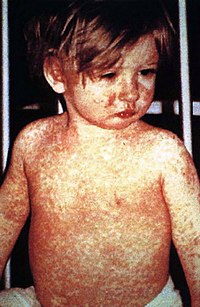
Photo from wikipedia
to phenotypic features. A clinically useful division into two groups can be made by the absence or presence of sweating: hypohidrotic and hidrotic. However, with increasing understanding of the genetics… Click to show full abstract
to phenotypic features. A clinically useful division into two groups can be made by the absence or presence of sweating: hypohidrotic and hidrotic. However, with increasing understanding of the genetics and molecular aetiology, classification by molecular pathway and gene mutation has been attempted. HED, the most common form of ED, occurs in ~1 in 5000–10 000 births. It is characterized clinically by the triad of hypodontia, hypotrichosis and hypohidrosis with additional phenotypic features. HED with X-linked inheritance (XHED, or Christ–Siemens–Touraine syndrome) with mutation of the ectodysplasin A gene (EDA) is the most common form, occurring in ~70% of patients; our patient’s family pedigree was consistent with X-linked inheritance, presenting with a milder phenotype in his sister. Palmoplantar keratoderma is a common but not universal feature of hidrotic ED 2 (Clouston syndrome), which increases in severity with age. It is an autosomal dominant condition most often linked to heterozygous mutations in GJB6, gap junction beta-6 protein (Connexin 30). However, a literature search revealed only four reports of palmoplantar keratoderma in HED. Only one of these had genetic testing reported, confirming XHED in a Mexican family, with a missense mutation c.409T>C in the EDA gene, resulting in the amino acid substitution p(Leu56-Pro), different to the mutation found in our patient. In that report, hyperkeratosis was confined to the patients’ feet and they had short, widely spaced toes, findings not present in our patient. To our knowledge, this is the second report of a genetically confirmed case of XHED with keratoderma, confirming an association with XHED. This case suggests that palmoplantar keratoderma may be considered an uncommon manifestation of XHED. Recognition of this is important because, despite advances in the understanding of the genetics of ED, classification remains clinical for patients who do not have access to genetic testing.
Journal Title: Clinical and Experimental Dermatology
Year Published: 2019
Link to full text (if available)
Share on Social Media: Sign Up to like & get
recommendations!